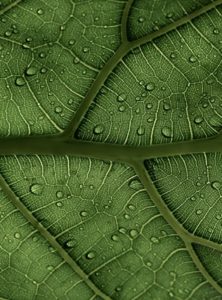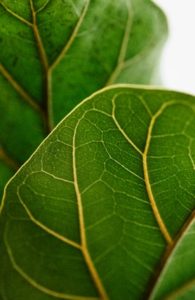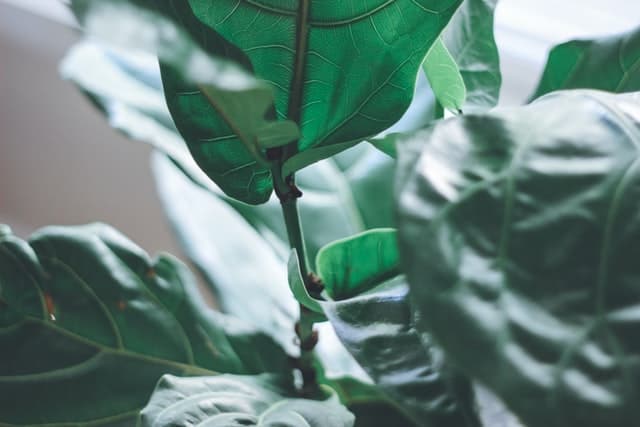Some links in the post are affiliate links and I get a commission from purchases made through some links found in the post.
It’s great to be able to show off a healthy fiddle leaf fig as they are among the most impressive plants around. However, when your fiddle leaf is not healthy it becomes a source of worry.
Maybe you have noticed fine spider webs among the leaves, and on closer inspection may even have seen tiny spiders crawling around. These are sure to be spider mites who love infecting fiddle leaf figs.
The bad news with spider mites is that they multiply quickly and before you know it they can literally take over your plant.
The good news is that you can stop the infestation and save the plant. To do this requires perseverance and persistence, but if you go about it correctly, you can save your fiddle leaf.
A Little About These Pesky Mites
 They are very difficult to see unless you have a microscope. Adult mites have eight legs, and their bodies are oval shaped. They come in different colours, and you may have heard them called web spinning mites, because that is what they do.
They are very difficult to see unless you have a microscope. Adult mites have eight legs, and their bodies are oval shaped. They come in different colours, and you may have heard them called web spinning mites, because that is what they do.
A horrible thought to remember is that they can double the size of the infestation every few weeks, which is why it is important to regularly check your fiddle leaf for them.
The spider mite grows to full adulthood in just a week and within two weeks the females can lay hundreds of eggs on the bottom sides of your fiddle leaves.
In warm, dry conditions they breed extremely fast, so it is vital that the air around your fiddle leaf is moist and humid.
The ideal time for spider mites to breed is when there is no heating in the house and the air has dried out.
How do They Get Onto your Fiddle Leaf?
They ride the breeze. Very delicate strands of web blow around, carrying the mites with them.
Because of the small size, you may never even notice the webbing. In fact, it is so fine that it can even pass through fly screens on windows and doors.
What do Spider Mites Eat?
They live on materials from plant cells. They target the moist areas of the leaves and suck the moisture from the plant, which explains why you may see your fiddle fig leaves start to shrivel up.
Eventually the leaves with simply drop off from the plant, and if left unattended, the plant may eventually die.
You may also like: Why does your fiddle leaf fig have multiple stems
What are the Signs of Spider Mites on Your Fiddle Leaf Fig?
Miniature spiders/small dots
If you take a magnifying glass and look at the small red or brown dots on the leaves you will see that they are moving – they are the spider mites.
Check closely and you will see these creatures. They are not insects. They are classed as arachnids.
Check the leaves
You may see spotted and discoloured leaves and even tiny white spider webs. The webs are very delicate, and you should spot them in the corners of the stems or under the leaves.
Little holes
If you notice tiny holes in the leaves then you can be certain that spider mites are invading your plant.
You will mainly see tiny holes along the spines of the leaves because the mites will invade the moister areas of the leaves and suck the liquid from there.
How to get Rid of Spider Mites on a Fiddle Leaf Fig
To get rid of spider mites, a good way to check if your fiddle leaf fig is in fact infested is to gently shake the leaves onto a large piece of white paper.
You should be able to see tiny dark coloured things crawling about. On contrast paper this should be visible with the naked eye.
Note: it is very important that you also make sure to wash your hands well after handling a plant where there is an infestation because you can easily pass on the mites. Pay particular attention to the areas under your nails where they may hide.
You should also dispose of the infected areas carefully because if they touch any other plants you will simply be passing the infestation on.
Place a large bin liner close by and insert any leaves that you have cut off inside the bag. This will ensure that no part of the infected leaves touches any surface, and there is no chance of spider mites moving elsewhere.
1) Give your Fiddle Leaf a Bath
By spraying the plant regularly with a hose, you will be able to get rid of the infestation and prevent any new infestations from starting.
Make sure that the water is at room temperature and aim for the underneath of the leaves where the spiders target first.
Although you can wipe the leaves with a damp cloth, a good shower is better and works quicker.
2) Check the Humidity

Spider mites do well in dry environments so aim for more humidity with your fiddle leaf.
It is a good idea to make use of a pebble tray to increase the humidity. Place a tray under the pot, fill with small pebbles and then add water. This will not in itself get rid of the infestation, but it will help.
To increase the humidity, you can also add a layer of peat moss around the base of the plant.
If you have central heating in your house, you are unwittingly making a breeding ground for spider mites. You may want to move your fiddle leaf to an area where you can control the humidity and keep the air moist.
3) Spray Your Fiddle Leaf Fig with Neem Oil
Insecticidal sprays and neem oil works well against spider mites, although they must be used on a regular basis to be effective.
You should change between insecticidal spray and neem oil so that the mites do not build up an immunity against one or the other.
4) Keep Your Fiddle Leaf Fig Apart From Other Plants
Because spider mites can go from plant to plant it is a good idea to keep your infected fiddle leaf apart from other plants until the infestation is over.
5) Use Predatory Mites
There are predatory mites which feed on spider mites, namely persimilis and fallacis,
Persimilis thrive on eating spider mites, in fact they will head directly to the spider web and start there, eating as many mites as they can.
If you opt to introduce them then remember that they need humidity of 60 percent to survive. You can also keep them happy by misting twice a day.
For heavy infestations you may need to introduce them again in a week.
Fallacis are also excellent predators of spider mites. You can introduce them after the persimilis have done their work. They will feed on the bodies of the spider mites and will prevent any further outbreaks.
These little creatures can even be introduced to ‘clean’ plants to keep them mite free.
If you’re enjoying this article, check out our article on how to use diatomaceous earth to control spider mites.
Can a Fiddle Leaf Fig Recover from Spider Mites?
The good news here is yes, it can recover from spider mites, unless the infestation has overtaken the entire plant.
Plants that only have a few damaged leaves will recover, although plants with excessive infestations will need more attention.
With a good routine and perseverance your fiddle leaf can recover from spider mites.
How do I Protect my Spider Mites from Fiddle Leaf Fig?
Because spider mites thrive in dry conditions, you should aim to keep the area around your fiddle leaf humid.
You may want to consider a humidifier into the room, or at least spray the plants with a fine mist to keep them humid.
Another idea is to leave a container of water close by to evaporate near your plant.
Doing a regular check on any other plants close to your fiddle fig will show you the first signs of infestations on other plants which my go on to infect your fiddle leaf.
Spider mites love the dusty dry conditions that we often see on plants with big leaves, so it is worth using a damp cloth to clean the dust from the leaves regularly.
Can Spider Mites Jump to Other Plants?
Although they don’t seem to leave the plant they are feeding on very often, if another plant is touching your fiddle leaf, you may find that the mites infect it as well.
Mites can drop from the infected plant and crawl to another source of food, breed and go on to infect the next plant. Because of this it is worth keeping plants apart from each other.
These pests can also be transported from one plant to another on clothing or any objects that touch the infestation.
Any spider mites that drop on to the ground and cannot get to another plant will simply die and can be swept away or vacuumed up.
If you plan to bring your fiddle leaf inside as the temperatures drop, then be sure to check it outside before you do this. It will be easier to hose the plant down outside and get rid of the infestation before it comes inside.
Final Thoughts
 No one likes the thought of a bunch of tiny creepy crawlies in their home! Even worse when you know that they are there, and you cannot see the little pests.
No one likes the thought of a bunch of tiny creepy crawlies in their home! Even worse when you know that they are there, and you cannot see the little pests.
Once you realise that your fiddle leaf is infested, the best thing to do is to isolate it right away while you treat it.
Take your time and do the job slowly and methodically, check each leaf both top and underneath for small gatherings of mites and carefully remove any that you find.
Once you have removed all that you can find, keep your fiddle leaf in isolation for a week or so until you are certain that the mites have been removed. Doing this will protect any other plants nearby.
With regular checking and careful treatment, your fiddle leaf should remain in good, healthy condition for many years.
Before you go, here are some more related articles I encourage you to read below to help solve more of your gardening issues:
Why are my Fiddle Leaf Fig Roots Showing
How to Care for a Fiddle Leaf Fig Outside
How to use Neem Oil & Does Neem Oil Kill Spider Mites

